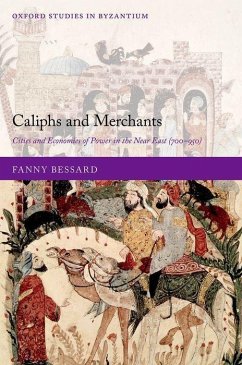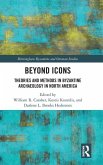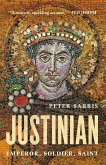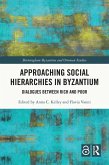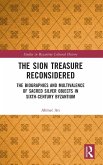Schade – dieser Artikel ist leider ausverkauft. Sobald wir wissen, ob und wann der Artikel wieder verfügbar ist, informieren wir Sie an dieser Stelle.
- Gebundenes Buch
- Merkliste
- Auf die Merkliste
- Bewerten Bewerten
- Teilen
- Produkt teilen
- Produkterinnerung
- Produkterinnerung
The foundation of the Muslim world from 700 to 950 was a seminal period in history, when the Near East enjoyed an age of political unity, prosperity, and cultural dominance. This volume offers new insights into the origins of the economic success of the early Islamic Caliphate, drawing instructive parallels within the contemporary Eurasian context.
Andere Kunden interessierten sich auch für
![Beyond Icons Beyond Icons]() Beyond Icons189,99 €
Beyond Icons189,99 €![Justinian Justinian]() Peter SarrisJustinian28,99 €
Peter SarrisJustinian28,99 €![The Life and Death of Ancient Cities The Life and Death of Ancient Cities]() Greg Woolf (DirectorThe Life and Death of Ancient Cities39,99 €
Greg Woolf (DirectorThe Life and Death of Ancient Cities39,99 €![Rome Resurgent Rome Resurgent]() Peter HeatherRome Resurgent28,99 €
Peter HeatherRome Resurgent28,99 €![From Byzantium to Constantinople From Byzantium to Constantinople]() John MatthewsFrom Byzantium to Constantinople104,99 €
John MatthewsFrom Byzantium to Constantinople104,99 €![Approaching Social Hierarchies in Byzantium Approaching Social Hierarchies in Byzantium]() Approaching Social Hierarchies in Byzantium198,99 €
Approaching Social Hierarchies in Byzantium198,99 €![The Sion Treasure Reconsidered The Sion Treasure Reconsidered]() Ar &The Sion Treasure Reconsidered167,99 €
Ar &The Sion Treasure Reconsidered167,99 €
The foundation of the Muslim world from 700 to 950 was a seminal period in history, when the Near East enjoyed an age of political unity, prosperity, and cultural dominance. This volume offers new insights into the origins of the economic success of the early Islamic Caliphate, drawing instructive parallels within the contemporary Eurasian context.
Produktdetails
- Produktdetails
- Verlag: Oxford University Press
- Seitenzahl: 400
- Erscheinungstermin: 27. Dezember 2020
- Englisch
- Abmessung: 237mm x 160mm x 28mm
- Gewicht: 820g
- ISBN-13: 9780198855828
- ISBN-10: 0198855826
- Artikelnr.: 58408396
- Herstellerkennzeichnung
- Libri GmbH
- Europaallee 1
- 36244 Bad Hersfeld
- gpsr@libri.de
- Verlag: Oxford University Press
- Seitenzahl: 400
- Erscheinungstermin: 27. Dezember 2020
- Englisch
- Abmessung: 237mm x 160mm x 28mm
- Gewicht: 820g
- ISBN-13: 9780198855828
- ISBN-10: 0198855826
- Artikelnr.: 58408396
- Herstellerkennzeichnung
- Libri GmbH
- Europaallee 1
- 36244 Bad Hersfeld
- gpsr@libri.de
Fanny Bessard is a historian of early and classical Islam with expertise in Arabic historiography, as well as a practicing archaeologist with a decade of field experience in the Near East and Central Asia. Before joining the University of Oxford she held a Newton International Fellowship at SOAS (2013-15), a Leverhulme Early Career Fellowship at the University of St Andrews (2015-16), and a Lectureship in the Department of Historical Studies at the University of Bristol (2016-19). Her main research interests lie in the social and economic transformations of the Near East from 700 to 1000.
* Frontmatter * List of Illustrations * List of Abbreviations * Notes on Transcription and Dates * Maps * 0: Introduction * 1: The Historical Context * 1. Conquests * 2. Ideology * 3. Agriculture * 4. Trade * PART I. PATRONAGE AND POWER * 2: A Stamp of Authority * 1. A Caliphal officium * 2. Sowing and reaping * 3. Exercise and assertion of power * 3: New Perspectives on Urban Economic Planning * 1. Growth of communal working areas in the Levant (700-750) * 2. Process of exclusion of economic clusters under early 'Abb
sid rule * 3. Rabä in Central Asia * 4. Isolation of domesticity * 4.1. Productive and public use to domestic shelter * 4.2. An emphasis on intimacy * 3a: Conclusion * PART II. REVISITING THE LEGACIES * 4: Artisans to Producers * 1. The progression of change * 1.1. Persistence of Roman practices after 700 * 1.2. Downfall of 'home' production after 800 * 2. Approaches to key industries * 2.1. Pottery * 2.2. Glass-making * 2.3. Textile industry * 3. Food processing industries * 3.1. Oil and wine industries * 3.2. Watermills * 5: Reshaping Market-Places * 1. From the ergast
rion to the s
q * 2. Covered market-places * 2.1. Funduq * 2.2. D
r, nh
n, and qays
riyya * 5a: Conclusion * PART III. INSTITUTIONAL AND RELIGIOUS GENERATORS * 6: Money Supply and Currency * 1. Out with the old * 2. Coinage in common * 3. Balancing supply and demand * 7: Islamifying the Economy * 1. Commercial rituals and Islamic worship * 2. Mosques and measures * 3. The mu
tasib * 7a: Conclusion * PART IV. ECONOMY AND SOCIAL CHANGES * 8: The Evolution of Labour Patterns * 1. Conditions of labour * 1.1. Servile labour * 1.2. Free labour * 1.3. Wage labour * 2. Changing patterns of institutional identity * 3. Status and composition of the labour force * 3.1. Disdained and tolerated professions * 3.2. Changing division of labour * 3.3. Female artisans * 9: Twilight of the Clerical and Landowning Elite, Rise of Tu%g%g
r * 1. Retailers and traders before 800 * 2. Ascendance of tu%g%g
r from 800 * 2.1. Financial * 2.2. Identity * 2.3. Cultural * 3. Tu%g%g
r's political and religious careers * 4. Tu%g%g
r and authority * 4.1. The defense of trading interests * 4.2. Tu%g%g
r and economic expansion * 9a: Conclusion * 10: Conclusion * Endmatter * Appendix * References * Index
sid rule * 3. Rabä in Central Asia * 4. Isolation of domesticity * 4.1. Productive and public use to domestic shelter * 4.2. An emphasis on intimacy * 3a: Conclusion * PART II. REVISITING THE LEGACIES * 4: Artisans to Producers * 1. The progression of change * 1.1. Persistence of Roman practices after 700 * 1.2. Downfall of 'home' production after 800 * 2. Approaches to key industries * 2.1. Pottery * 2.2. Glass-making * 2.3. Textile industry * 3. Food processing industries * 3.1. Oil and wine industries * 3.2. Watermills * 5: Reshaping Market-Places * 1. From the ergast
rion to the s
q * 2. Covered market-places * 2.1. Funduq * 2.2. D
r, nh
n, and qays
riyya * 5a: Conclusion * PART III. INSTITUTIONAL AND RELIGIOUS GENERATORS * 6: Money Supply and Currency * 1. Out with the old * 2. Coinage in common * 3. Balancing supply and demand * 7: Islamifying the Economy * 1. Commercial rituals and Islamic worship * 2. Mosques and measures * 3. The mu
tasib * 7a: Conclusion * PART IV. ECONOMY AND SOCIAL CHANGES * 8: The Evolution of Labour Patterns * 1. Conditions of labour * 1.1. Servile labour * 1.2. Free labour * 1.3. Wage labour * 2. Changing patterns of institutional identity * 3. Status and composition of the labour force * 3.1. Disdained and tolerated professions * 3.2. Changing division of labour * 3.3. Female artisans * 9: Twilight of the Clerical and Landowning Elite, Rise of Tu%g%g
r * 1. Retailers and traders before 800 * 2. Ascendance of tu%g%g
r from 800 * 2.1. Financial * 2.2. Identity * 2.3. Cultural * 3. Tu%g%g
r's political and religious careers * 4. Tu%g%g
r and authority * 4.1. The defense of trading interests * 4.2. Tu%g%g
r and economic expansion * 9a: Conclusion * 10: Conclusion * Endmatter * Appendix * References * Index
* Frontmatter * List of Illustrations * List of Abbreviations * Notes on Transcription and Dates * Maps * 0: Introduction * 1: The Historical Context * 1. Conquests * 2. Ideology * 3. Agriculture * 4. Trade * PART I. PATRONAGE AND POWER * 2: A Stamp of Authority * 1. A Caliphal officium * 2. Sowing and reaping * 3. Exercise and assertion of power * 3: New Perspectives on Urban Economic Planning * 1. Growth of communal working areas in the Levant (700-750) * 2. Process of exclusion of economic clusters under early 'Abb
sid rule * 3. Rabä in Central Asia * 4. Isolation of domesticity * 4.1. Productive and public use to domestic shelter * 4.2. An emphasis on intimacy * 3a: Conclusion * PART II. REVISITING THE LEGACIES * 4: Artisans to Producers * 1. The progression of change * 1.1. Persistence of Roman practices after 700 * 1.2. Downfall of 'home' production after 800 * 2. Approaches to key industries * 2.1. Pottery * 2.2. Glass-making * 2.3. Textile industry * 3. Food processing industries * 3.1. Oil and wine industries * 3.2. Watermills * 5: Reshaping Market-Places * 1. From the ergast
rion to the s
q * 2. Covered market-places * 2.1. Funduq * 2.2. D
r, nh
n, and qays
riyya * 5a: Conclusion * PART III. INSTITUTIONAL AND RELIGIOUS GENERATORS * 6: Money Supply and Currency * 1. Out with the old * 2. Coinage in common * 3. Balancing supply and demand * 7: Islamifying the Economy * 1. Commercial rituals and Islamic worship * 2. Mosques and measures * 3. The mu
tasib * 7a: Conclusion * PART IV. ECONOMY AND SOCIAL CHANGES * 8: The Evolution of Labour Patterns * 1. Conditions of labour * 1.1. Servile labour * 1.2. Free labour * 1.3. Wage labour * 2. Changing patterns of institutional identity * 3. Status and composition of the labour force * 3.1. Disdained and tolerated professions * 3.2. Changing division of labour * 3.3. Female artisans * 9: Twilight of the Clerical and Landowning Elite, Rise of Tu%g%g
r * 1. Retailers and traders before 800 * 2. Ascendance of tu%g%g
r from 800 * 2.1. Financial * 2.2. Identity * 2.3. Cultural * 3. Tu%g%g
r's political and religious careers * 4. Tu%g%g
r and authority * 4.1. The defense of trading interests * 4.2. Tu%g%g
r and economic expansion * 9a: Conclusion * 10: Conclusion * Endmatter * Appendix * References * Index
sid rule * 3. Rabä in Central Asia * 4. Isolation of domesticity * 4.1. Productive and public use to domestic shelter * 4.2. An emphasis on intimacy * 3a: Conclusion * PART II. REVISITING THE LEGACIES * 4: Artisans to Producers * 1. The progression of change * 1.1. Persistence of Roman practices after 700 * 1.2. Downfall of 'home' production after 800 * 2. Approaches to key industries * 2.1. Pottery * 2.2. Glass-making * 2.3. Textile industry * 3. Food processing industries * 3.1. Oil and wine industries * 3.2. Watermills * 5: Reshaping Market-Places * 1. From the ergast
rion to the s
q * 2. Covered market-places * 2.1. Funduq * 2.2. D
r, nh
n, and qays
riyya * 5a: Conclusion * PART III. INSTITUTIONAL AND RELIGIOUS GENERATORS * 6: Money Supply and Currency * 1. Out with the old * 2. Coinage in common * 3. Balancing supply and demand * 7: Islamifying the Economy * 1. Commercial rituals and Islamic worship * 2. Mosques and measures * 3. The mu
tasib * 7a: Conclusion * PART IV. ECONOMY AND SOCIAL CHANGES * 8: The Evolution of Labour Patterns * 1. Conditions of labour * 1.1. Servile labour * 1.2. Free labour * 1.3. Wage labour * 2. Changing patterns of institutional identity * 3. Status and composition of the labour force * 3.1. Disdained and tolerated professions * 3.2. Changing division of labour * 3.3. Female artisans * 9: Twilight of the Clerical and Landowning Elite, Rise of Tu%g%g
r * 1. Retailers and traders before 800 * 2. Ascendance of tu%g%g
r from 800 * 2.1. Financial * 2.2. Identity * 2.3. Cultural * 3. Tu%g%g
r's political and religious careers * 4. Tu%g%g
r and authority * 4.1. The defense of trading interests * 4.2. Tu%g%g
r and economic expansion * 9a: Conclusion * 10: Conclusion * Endmatter * Appendix * References * Index

